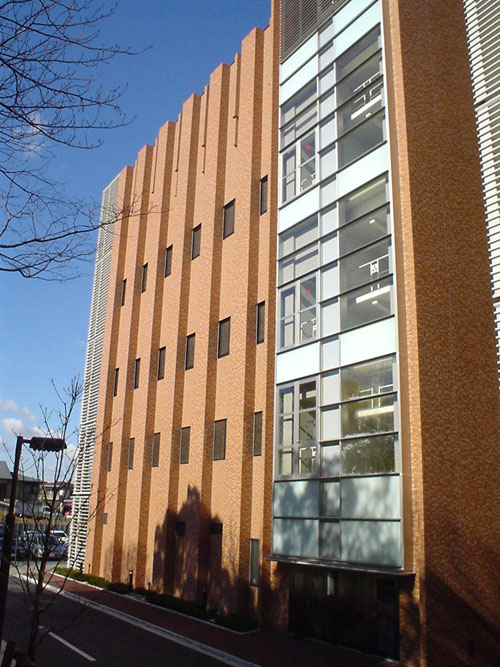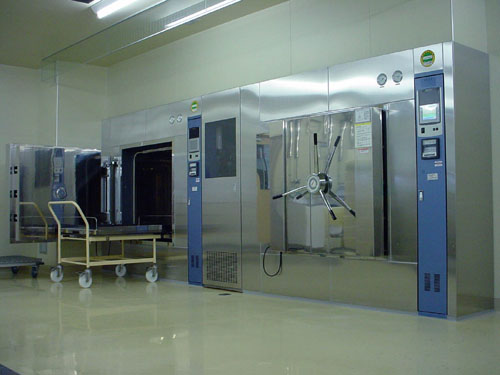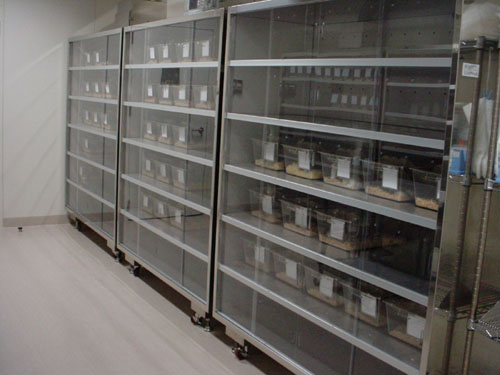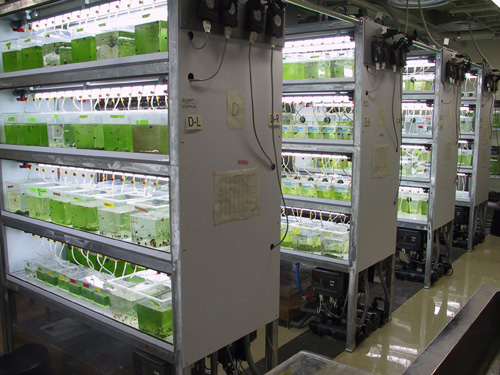

|
CENTER FOR TRANSGENIC ANIMALS AND PLANTS |
| Head: | TAKADA, Shinji |
| Associate Professors: | WATANABE, Eiji |
| SASAOKA, Toshikuni | |
| TANAKA, Minoru | |
| Technical Staffs: | HAYASHI, Kohji |
| ICHIKAWA, Hiromi (Jun. ’04 -) | |
| Supporting Staffs: | YASUDA, Mie |
| SHIMIZU, Naoki (- Jul. ’04) | |
| YAMAGUCHI, Kyoko | |
| YOSHIDA, Etsuko | |
| KAWAMURA, Motofumi (Jun. ’04 -) |
|
The worldwide genome project has been almost completed, and research on basic biology comes to post genome era in which researches focus on investigating of a function of an individual gene. To promote functional analysis of a gene of interest it is essential to utilize genetically altered model organisms, which are generated by the genetic engineering technology, the creation of gene deletion, gene replacement or point mutation. NIBB Center for Transgenic Animals and Plants (CTAP) was established in April 1998 to support researches using transgenic and gene targeting techniques in NIBB. The CTAP began to be managed by the head (professor, a concurrent post) and an associate professor. |
 |
|
Figure 1. A new center facility for transgenic animals in the Yamate area. |
|
Technical staffs and supporting staffs develop and promote research supporting activities. In 2003 two associate professors joined in the CTAP. A new CTAP building for transgenic animals in the Yamate area has opened in the end of 2003 (Figure 1). The expected activities of the CTAP are as follows: 1. Provision of information, materials, techniques and animal housing space to researchers. 2. Equipment of various kinds of instruments to analyze mutant, transgenic, and gene-targeted animals and plants. 3. Development of novel techniques related to transgenic and gene targeting technology. 4. Cryopreservation and storage of transgenic strains.
I. Research supporting activity (mouse)In 2001 the NIBB mouse facility under the specific pathogen free (SPF) condition opened in the Myodaiji area and the production, breeding, analysis, cryopreservation and storage of genetically manipulated mouse strains has been conducted. The new CTAP building in the Yamate area strengthened research activities using genetically altered organisms (Figure 1). The building has five floors and a total floor space of 2,500m2, in which we can generate, breed, store and analyze transgenic, gene targeting and mutant mice under SPF condition. This building is also equipped with breeding areas for transgenic small fish, birds and insects on the first floor. The mouse housing area of this building is constructed based on a barrier system in which the clean area and the semi-clean area are clearly separated and designed for an efficient and one-directional flow of mice, personnel, articles of animal housing and equipments from the clean area side to the semi-clean area side. |
 |
|
Figure 2. Autoclaves of a large scale for sterilization. |
|
Since research activities in the CTAP building in the Yamate area started in 2004, 3,138 mice brought into the CTAP, and 7,894 mice (including pups bred in the facility) were taken out from the CTAP from April 01, 2004 to December 14, 2004. A number of strains of genetically altered mice outside the CTAP were brought in the mouse housing area by microbiological cleaning using the in vitro fertilization-embryo transfer techniques, and stored by cryopreservation. A new mouse facility in the Myodaiji area is under the construction and will be open in the beginning of 2005. The facility provides research supporting activities to researchers in the Myodaiji area. |
 |
|
Figure 3. Breeding equipments for mutant mice under condition of specific pathogen-free. |
II. Research supporting activity (small fish, birds, and insects)The first floor of the CTAP building in the Yamate area provides space and facilities to maintain small fish, chick embryos and insects. In a laboratory room for chick embryos, a large incubation chamber is equipped and set at 42 degrees suitable for chick embryogenesis. For researchers who need fish, 480 tanks (1 litter) and 450 tanks (3 litters) are available for medaka and zebrafish, respectively. Water circulates and can be maintained to suit conditions desired for fish breeding in the aquarium systems. In addition to the rooms mentioned above, another room is available for insects. All the rooms are qualified to meet the criteria for P1A transgenic animals, allowing researchers to generate and maintain transgenic animals. |
 |
|
Figure 4. Breeding equipments for transgenic small fish. |
|
In 2004 (as of the end of November), 1,190 medaka (552 embryos and 638 adults) were brought to the facility and 19,776 medaka (15,757 fertilized eggs, 1,662 embryos, and 2,357 adults, including animals bred in the facility) were taken out from the CTAP. In a laboratory for chick embryos 20,349 fertilized chicken eggs were brought in and 213 animals (123 fertilized eggs, 85 embryos and 5 broods) were taken out from the CTAP. These animals were used for the research activities in neurobiology and developmental biology. Academic activityThe associate professors of this center, E. Watanabe, T. Sasaoka, M. Tanaka, are the principal investigators of Laboratory of Neurophysiology, Laboratory of Neurochemistry and Laboratory of Molecular Genetics for Reproduction, respectively. Laboratory of Neurophysiology is studying the brain sensing system for the water and sodium homeostasis in the body fluid by using gene-targeting mice, Laboratory of Neurochemistry is studying a physiological role of dopaminergic system using genetically altered mice, and Laboratory of Molecular Genetics for Reproduction is studying molecular mechanism of reproductive organ development and sex differentiation using mutagenized or transgenic medaka. For details, please refer to academic activity of each laboratory. |
 |